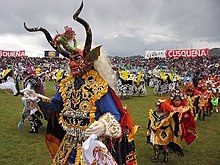| Revision as of 12:40, 2 August 2009 editDentren (talk | contribs)Autopatrolled, Extended confirmed users, Pending changes reviewers37,577 editsNo edit summary← Previous edit | Revision as of 15:44, 2 August 2009 edit undoAlexbot (talk | contribs)196,144 editsm robot Adding: es:DiabladaNext edit → | ||
| Line 12: | Line 12: | ||
| ] | ] | ||
| ] | |||
| ] | ] | ||
| ] | ] | ||
Revision as of 15:44, 2 August 2009


The Diablada is a dance, with auto sacramental origins in Spain that is practised in various regions of the Andes specially the Altiplano (Bolivia, southern Perú, Venezuela and nortern Chile).
This mainly Andean theatrical reportoire that began during the Spanish colonization of South America in order to teach the local natives the precepts of Christian faith and history of the Spanish Empire. The diablada causes a reform in the thinking of the indigenous altiplano cultures as missionaries from Spain, instilled the paradigm of good and evil, which is how the costumes of angels and demons became associated with the dance.
This dance-related article is a stub. You can help Misplaced Pages by expanding it. |